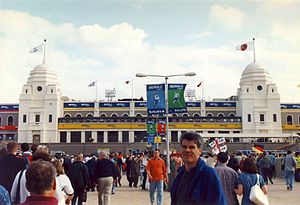Wembley Stadium (1924)
| The Twin Towers, Original Wembley | |
 |
|

|
|
| Former names | Empire Stadium British Empire Exhibition Stadium |
|---|---|
| Location | Wembley, London, England |
| Coordinates | 51°33′20″N 0°16′47″W / 51.55556°N 0.27972°WCoordinates: 51°33′20″N 0°16′47″W / 51.55556°N 0.27972°W |
| Owner | Wembley Company |
| Capacity | 82,000 (originally 127,000) |
| Surface | Grass and track |
| Construction | |
| Broke ground | 1922 |
| Opened | 28 April 1923 |
| Renovated | 1963 |
| Closed | 7 October 2000 |
| Demolished | 2002–2003 |
| Rebuilt | Replaced 2007 by the new Wembley Stadium (also known as New Wembley) |
| Construction cost | £750,000 GBP (1923) |
| Architect | Sir John William Simpson and Maxwell Ayrton Sir Owen Williams (engineer) |
| Tenants | |
|
England national football team (1923–2000) London Monarchs (1991–1992) Wembley Lions speedway team (1946–1957, 1970–1971) Arsenal FC European games (1998–2000) Leyton Orient FC (1930) World Games 1985 |
|
The Original Wembley Stadium (/ˈwɛmbli/; formerly known as the Empire Stadium) was a football stadium located in Wembley Park, London. It stood on the site now occupied by its successor, the new Wembley Stadium.
It was famous for hosting the annual FA Cup finals, five European Cup finals, the 1948 Summer Olympics, the 1966 World Cup Final, the final of Euro 96, and the 1992 and 1995 Rugby League World Cup Finals. The great Brazilian footballer Pelé once said of the stadium, "Wembley is the cathedral of football. It is the capital of football and it is the heart of football" in recognition of its status as the world's best-known football stadium. It also hosted numerous music events, including the 1985 Live Aid charity concert.
The twin towers were an icon for England and Wembley, and their demolition in 2003 upset many members of the public. Debris from the Original Wembley Stadium was used to make the award-winning Northala Fields in Northolt, Ealing.
...
Wikipedia
